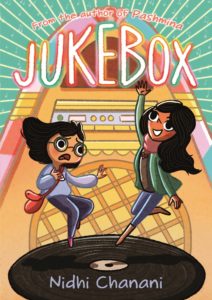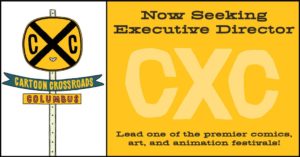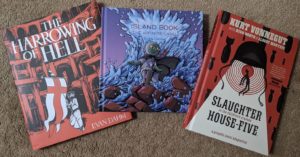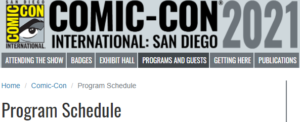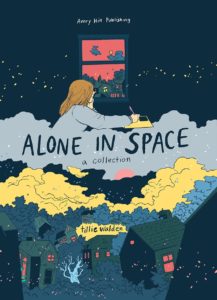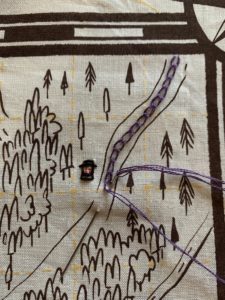Fleen Book Corner: Jukebox
This review is going to be a bit briefer than many of my past reviews; it’s because of other stuff in my life, not because the book doesn’t deserve more words. In fact, I’ll say that it deserves all the words (some of which are spoilers), but let’s not get ahead of ourselves.
Jukebox is the sophomore graphic novel from Nidhi Chanani; full disclosure, she’s a friend of mine and we have spent time at Comics Camp in the past and hopefully will do so again in the future. When her first graphic novel, Pashmina, came out, I said:
[W]hen the worst I can say of a book is that I wish it had another three dozen pages to spend on its protagonist, you’re doing pretty damn well, and debut stories aren’t given the resources of proven creators. I expect that Chanani’s next book will reflect an increase in confidence from the market and the pages that will come with it.
I’m going to modestly declare, called it; Jukebox gets the pages needed to let the story breathe and as a result it’s a more satisfying reading experience. It’s also got one of the most unusual structures I’ve ever seen in a complete story, in that there isn’t really an antagonist¹.
Let me back up.
Jukebox is the story of Shaheen, San Francisco tween who’s relationship with her father Giovanni is defined by music. He’s a vinyl collector with eclectic tastes and determined that his daughter grow to love the depth and breadth of music as he does. Every song has a story, and a backstory, and context and history and details and, and, and … and Shaheen thinks that maybe Dad could take a bit of interest in what she likes. Anything other than the latest, timeless acquisition. It’s a point of friction between them.
Until he disappears. As does his vinyl dealer. They’re traced to a room with a mysterious jukebox that’s been designed to play whole albums rather than singles, and Shaheen finds herself and her cousin Tannaz flung through time and space as she plays her Dad’s favorites. He was lost somewhere relevant to whatever was playing on the jukebox when he was whisked away, and has no way to return unless Shahi and Naz can find him.
So if Shahi’s the hero of this story — which isn’t afraid to make her alternately timid, stubborn, scared, and a bit selfish — and Naz is the sidekick and Dad is the princess to be rescued, who’s the villain? Earl, the vinyl store owner who created the jukebox and has been using it to plunder the past of valuable first pressings to sell? Not really, he’s misguided.
The real antagonist is the overly obsessive focus that both Earl and Giovanni have for their music collections, which their lives revolve around in different ways, which alienate them from others. It’s not greed so much as it is excessive fanboyism, and if that’s not a lesson for the modern culture, I’m not sure what is². It’s only by loosening up, finding other interests, becoming broader people that Gio and Earl can put their lives back in balance. Their health, too, as the jukebox carries a cost to use it — it steals your hearing in one of the great ironic punishments. Seriously, this is the genie in the lamp ironically fulfilling your wish territory, which never turns out well unless you’re a sociopath.
Uh, maybe don’t share that last link with any of the 10-14 year olds that you give the book to. But definitely give them the book and an afternoon to devour it. They’ll learn about some key points in history (that don’t revolve around white dudes — that’s part of why Shahi and Naz don’t find Gio in their first four or five jaunts), about taking care of vinyl, and about how you can love somebody and still be totally exasperated at them at the same time.
All of it is wrapped up in Chanani’s open, inviting, slightly cartoony and very vibrant art that shifts color palette a half dozen times to portray a half dozen different moods. You’ll finish reading and want to put on a favorite playlist — just don’t go so loud you hurt your ears.
Jukebox, with words and pictures by Nidhi Chanani, is published by :01 Books and continues their long streak of excellent graphic novels. It’s available at book and comic shops everywhere, and maybe even a record store or two.
Spam of the day:
When the Ring Won’t Stop, Eat this Brain (Nutrient Removes Tinnitus)
Rarely do the spams and the post content line up so neatly. Not sure you want to be telling people to eat brains, though. That’s how you get zombies.
_______________
¹ To those confidently stating a compelling story must have an antagonist I have one word: Totoro.
² Honestly, it reminds me a bit of the heedless interest in food that Chihiro’s parents have at the start of Spirited Away. Her journey to redeem them has more than a few parallels here. Miyazaki’s influence reaches far.
